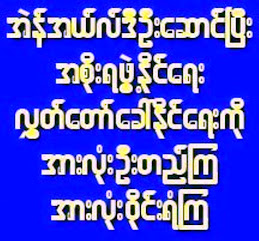| By AUNG NI | Wednesday, November 12, 2008 |
TAUNGGYI — Green and blue sparks pour like rain from the fire balloon in the clear sky above. People gasp and clap. The atmosphere is filled with the sound of Shan and Danu drums to the rhythm of traditional chanting.
This is the annual festival of Taunggyi Dazaungdaing. Everybody in town is there. Cafes, stalls and restaurants compete for business. Disco music blares out from every direction. But it is the sight of the enormous balloons that captures everyone’s imagination.
Each year in November the youngsters in Taunggyi go from door to door playing Shan and Danu drums, collecting donations for the festival’s fire balloons.
In fact, it was British officers who initiated the first hot-air balloon contest in Taunggyi in 1894, nine years after the annexation of Upper Burma.
Nowadays the balloons are the highlight of the Dazaungdaing festival, which takes place annually before the full moon in November. Normally, only Taunggyi residents compete in the hot-air balloon contests. But last year, Naypyidaw and Maymyo held their own festivals.
“Making the balloon takes a whole month,” said participant Nay Myo. “But then it only lasts 15 or 20 minutes. We are creating art, which we can hang in the sky."
Nay Myo and his fellow balloon-makers make offerings at the temple before they set fire to their work and set it off into the sky. They carry packages of bananas, coconut, candles, tea leaves and betel nut, which they offer to the guardian spirit of fire.
The average cost of a fire balloon is about 1.6 million kyat (US $1,280), but varies greatly if gunpowder or other incendiary materials are used. The balloon contest lasts nearly eight days, ending on the day of the full moon, which is the main celebratory day for Dazaungdaing.
Most balloons are made from a coarse paper made from mulberry pulp. One standard fire balloon requires about 1,200 sheets of paper.
“All the work is by hand, so we need many volunteers, much patience and unity of minds,” Nay Myo said. “We all have to share tasks in building a fire balloon.”
The candlewick for the balloon is wrapped in an iron mesh and covered in rags of a blanket which soak up the dregs of oil. The wick has to be one-third the height of the balloon and can weigh as much as 15 vises (25 kilos).
Traditionally, a mix of zinc, potassium and sulphur can be put together to make a green sparkler.
“We have many traditional formulas for making colors for the sparklers,” confides Nay Myo. “However, we keep the secret among our group and pass it down from generation to generation.”
In Taunggyi, contestants compete for three competitions: balloons decorated with fireworks (nya mee kyi), balloons decorates with lanterns (sein na pan), and a daytime event where huge balloons are shaped like animals (ayoke).
The animal balloons are known to cost between 100,000 and 500,000 kyat ($80 to $400), to build while the balloons with lanterns cost much more, up to 1 million kyat ($800). Teams often solicit sponsorship with companies keen to advertize their businesses on the side of the balloons.
Both the average diameter and height of the Taunggyi hot-air balloons is between 20 and 24 feet (about 7 meters).
“Although we have been competing for nearly 10 years, we still don’t have a sponsor,” said fire-balloon competitor Aung Phyu. “This year has been particularly difficult because of the economic crisis.”
At this year’s festival, organizers said that there are 51 entries in the fire-balloon class; 31 in the sein na pan contest and 200 ayoke competitors.
The first prize for the nya mee kyi winner is 3 million kyat ($2,400); 120,000 kyat ($96) for the sein na pan winner; and 130,000 kyat ($104) for the ayoke winner, plus all champions receive a cup.
However, Aung Phyu said that it was not about the money. “We want the prestige,” he said. “That’s our dream.”
Some 25 referees adjudicate the artwork and craftsmanship of the balloons.
"Some say that we are simply burning money,” said Nay Myo. “They don't understand our emotions or how much we value our hot-air balloon. When you plant a tree and it grows, how do you feel? This is our creation that we can see in the sky. I want us to preserve our culture and make it recognizable around the world.”







No comments:
Post a Comment